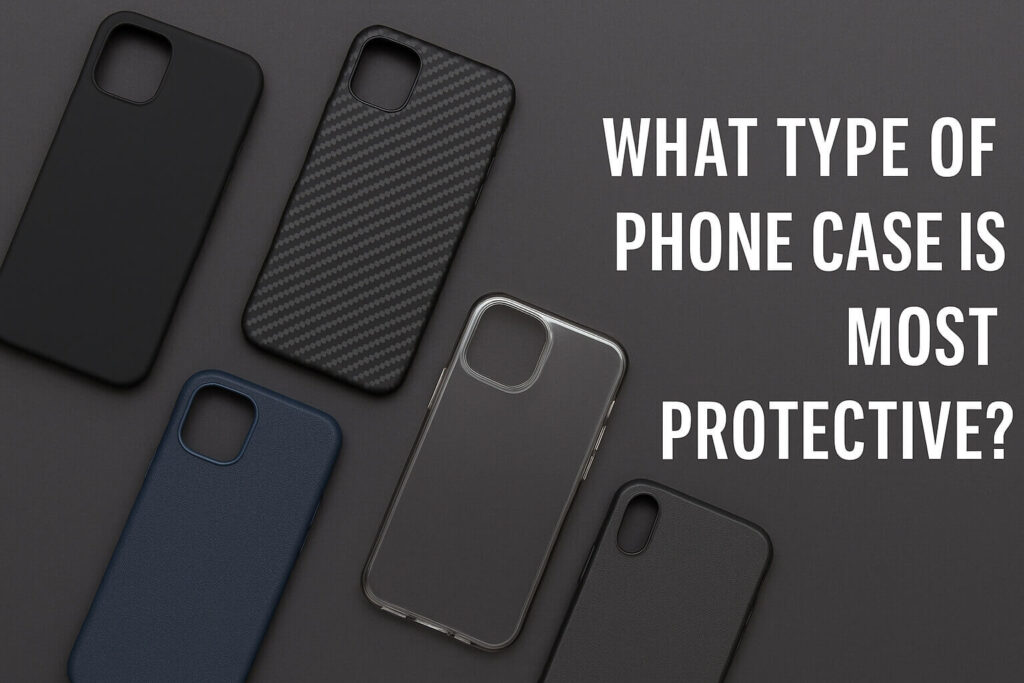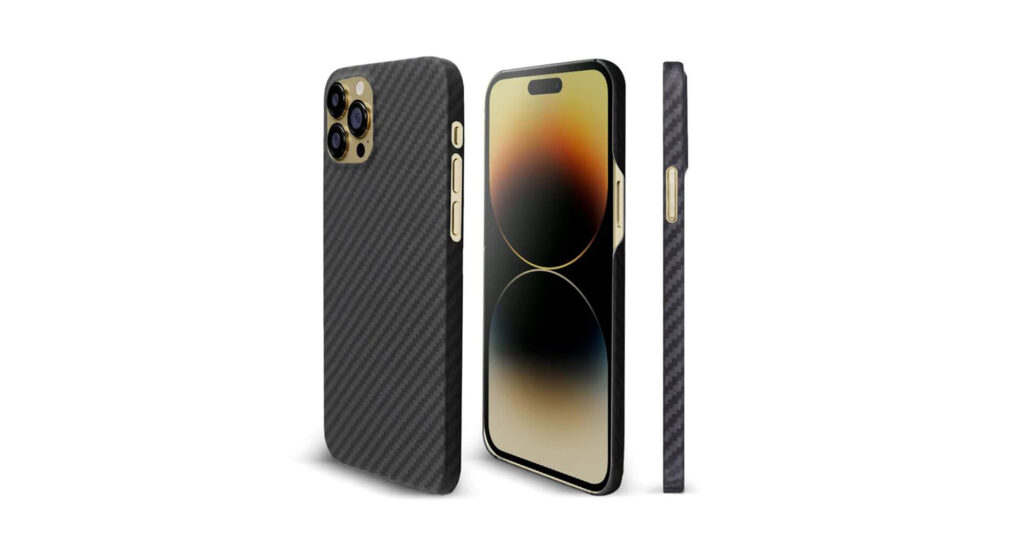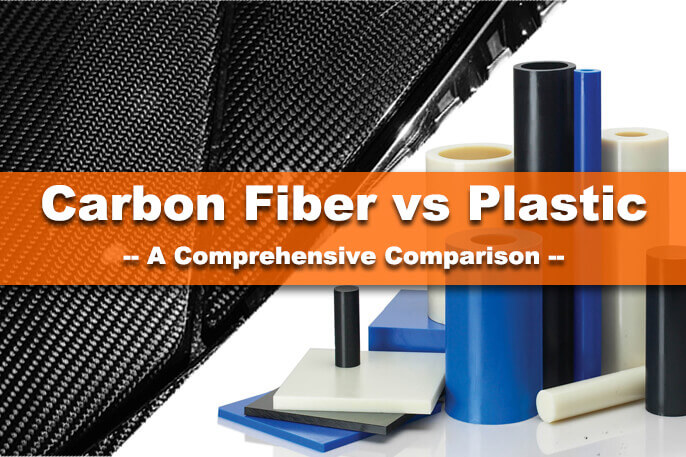Introduction
In today’s world, smartphones have become an essential part of our daily lives. We rely on them for communication, navigation, and entertainment.
This constant use also increases the risk of dropping and damaging our devices. A strong, well-designed phone case can save you from costly repairs or replacement.
In this article, we explore what makes a phone case truly protective. You’ll learn about the key criteria, the materials used, design features, and top recommendations. These include a close look at carbon fiber cases.
By the end, you’ll know exactly which type of phone case is most protective for your needs.

Key Criteria for Protection
Let’s discuss the factors that determine a case’s protective power first. This is important to know before we dive into the specific materials and designs of phone cases.
Experts typically evaluate phone cases on four main criteria:
- Drop Test Performance: Drop tests simulate real‑world accidents by dropping a phone from various heights onto different surfaces. The best cases absorb impact and minimize force transmission to the phone.
- Material Durability: This measures how well the case material resists wear and tear over time. High‑durability materials maintain structural integrity after countless drops and everyday use.
- Design and Usability: A case should protect without hindering functionality. Features like precise cutouts, tactile button covers, and ergonomic grips matter for daily use.
- Additional Features: Extras such as kickstands, belt clips, waterproof seals, and MagSafe compatibility can enhance a case’s usefulness and protection in different scenarios.
Understanding Drop Test Ratings
One of the most common claims is “military‑grade protection.” This refers to tests based on the U.S. military’s MIL‑STD‑810G standard. This standard specifies drop heights, surface types, and number of drops.
However, not all “military‑grade” cases offer identical protection. The rating sets a baseline but does not guarantee comprehensive performance across materials and designs.
MIL‑STD‑810G Standard
Covers drops from about 4 feet onto hard surfaces in multiple orientations.
Variations Among Brands
Different manufacturers add extra tests like abrasion, vibration, and temperature extremes. Oneou‘s DROP+ testing, for example, includes dozens of additional drops beyond the standard.
Common Phone Case Materials
The material of your phone case plays a vital role in protection. Here’s a breakdown of popular materials, their pros, and their cons:
| Phone Case Material | Pros | Cons |
|---|---|---|
| Silicone | Soft, good grip, inexpensive, weather‑resistant | Less structural strength; can stretch over time |
| TPU | Flexible yet durable, excellent shock absorption | Can yellow over time; slightly grips moisture |
| Polycarbonate | Very strong, rigid, resists deformation | Hard surface can slip; can leave marks on phone |
| TPE | Cheaper than TPU, moisture‑resistant, good cold tolerance | Less durable than TPU, prone to shrinkage |
| Rubber | Best shock resistance, high grip | Bulky; poor high‑temperature performance |
| Carbon Fiber | Exceptional strength‑to‑weight ratio, scratch‑resistant | Can block radio signals slightly; brittle under extreme stress |
| Aramid Fiber | Extremely strong; used in bulletproof gear | Very expensive; degrades under UV exposure |
| Metal | Premium feel, highest structural strength | Rigid (poor shock dispersion), can scratch device |
New—Carbon Fiber Deep Dive:
Carbon fiber cases use layers of woven carbon strands bonded with resin. This yields a case that is ultra‑light yet resists bending and abrasion better than most plastics. The stiffness helps distribute impact across the case surface, but in very sharp impacts the material can crack if overloaded. Most manufacturers combine a thin carbon‑fiber shell with a TPU inner liner so you get both rigidity and shock absorption in one package.
Comparison of the Protective Level of Different Phone Case Materials
When choosing a case, understand how different materials perform first. This will help you match the protection of these phone cases to your lifestyle.
Below is a comparison of the protective level of the most common phone case materials. It is rated on key factors: shock absorption, structural strength, scratch resistance, and weight.
| Material | Shock Absorption | Structural Strength | Scratch Resistance | Weight Impact | Overall Protection Level |
|---|---|---|---|---|---|
| Silicone | ★★★☆☆ | ★★☆☆☆ | ★★☆☆☆ | ★★★★☆ | Moderate |
| TPU | ★★★★☆ | ★★★☆☆ | ★★★☆☆ | ★★★☆☆ | Good |
| Polycarbonate | ★★☆☆☆ | ★★★★☆ | ★★★★☆ | ★★☆☆☆ | Good |
| Rubber | ★★★★★ | ★★★☆☆ | ★★☆☆☆ | ★★☆☆☆ | Very Good |
| Carbon Fiber | ★★★★☆ | ★★★★★ | ★★★★☆ | ★★★★★ | Excellent |
| Aramid Fiber | ★★★☆☆ | ★★★★★ | ★★★★☆ | ★★★★☆ | Excellent |
| Metal | ★★☆☆☆ | ★★★★★ | ★★★☆☆ | ★★☆☆☆ | Very Good |
- Shock Absorption: It measures how well the material cushions impacts. Rubber and TPU is good in this aspect, as they can dissipate force. However, rigid materials like metal absorb less shock directly.
- Structural Strength: This reflects the resistance to bending, crushing, and permanent deformation of the material. Carbon fiber, aramid, and metal rank highest in structure.
- Scratch Resistance: It gauges how well the surface resists scuffs. Hard, resin-coated weaves (carbon fiber) and polycarbonate are usually stronger than softer materials.
- Weight Impact: Considers how much weight the case adds. Lightweight choices (carbon fiber, silicone) score higher. Metal and thick rubber add noticeable heft.
- Overall Protection Level: It is an aggregate rating based on real-world drop tests, multi-layer design potential, and material properties.
Key Takeaways
- Best All-Rounder: Carbon fiber cases deliver an exceptional blend of shock dispersion and rigidity at minimal weight. Pair them with a TPU liner for maximum drop protection.
- Budget Friendly: TPU and polycarbonate hybrids offer good protection without a high cost. They’re easy to find and come in many styles.
- Maximum Cushioning: If you drop your phone frequently, rubber-lined or thick TPU cases is considerable. They provide the most direct impact absorption.
- Extreme Strength: For heavy-duty use (industrial, outdoor sports), aramid fiber or metal-reinforced cases are perfect option. They offer top-tier structural defense—though at the cost of added weight.
With this material-level comparison, you can choose a case that balances shock protection, durability, and comfort to suit your needs.
Extra Protective Features of Phone Case You Should Know
While material is crucial, other protective aspects can safeguard your phone:
- Raised Bezels: Choose a phone case has raised edges surrounding the screen and camera lenses. This design can prevent your phone’s screen and camera from direct surface contact.
- Port Covers: They can keep dust and moisture out of charging ports and headphone jacks.
- Built‑in Screen Protectors: Provide added defense against scratches and cracks without needing a separate glass protector.
- Grip Textures: This helps improve the in‑hand stability of the phone. And, they largely reduce the chance of accidental drops.
- MagSafe and Mounting Compatibility: Some cases integrate magnets or mounts. This ensures protection without losing accessory functionality.
How To Choose the Right Case for Your Needs?
Selecting the most protective phone case depends on how you use your phone:
- Everyday Use: A dual‑layer TPU and polycarbonate hybrid strikes the best balance between bulk and protection.
- Active Lifestyles: If you usually do sports and outdoor activities, consider rugged military‑grade cases. They usually have IP68 ratings and port covers.
- Carbon Fiber Fans: If you want maximum strength with minimal weight, carbon fiber phone cases from Oneou are top picks.
- Professional or Industrial Environments: Look for cases with crushproof and chemical‑resistant features will be a choice.
- Style‑Conscious Buyers: Slim protective cases offer elegance without sacrificing defense.
- Budget Constraints: Silicone or basic TPU cases deliver decent drop protection at low cost. They excel for daily bumps and minor drops.
Conclusion
What’s the most protective phone case? It should combine impact‑absorbing materials, rigorous testing, and thoughtful design.
Multi‑layer hybrid cases, military‑grade drop test designs, and specialized rugged models are good. They all offer exceptional defense.
Carbon fiber cases offer superior strength‑to‑weight ratios in ultra‑slim profiles. They can add an extra layer of protective performance.
Drop ratings, material properties, and additional protective features are the main aspects.
Whether you need everyday protection or gear for extreme conditions, there’s a case out there. Perhaps carbon fiber phone cases are tailored to your lifestyle.


